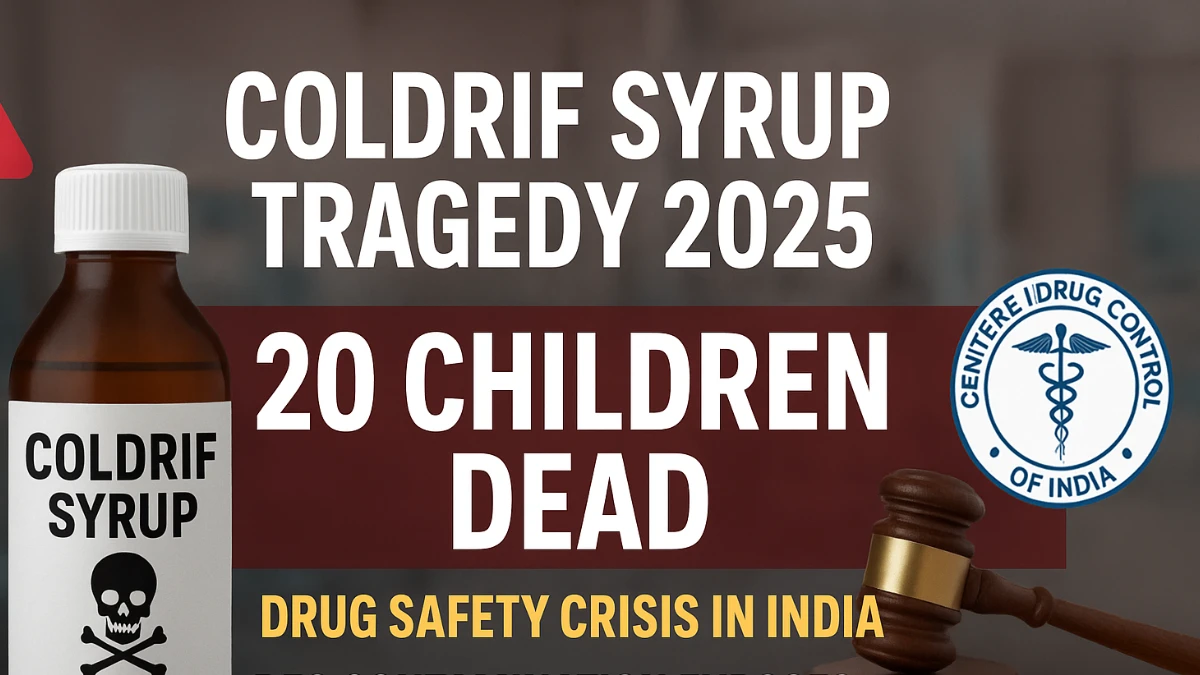Introduction
The tragic deaths of at least 20 children in India due to contaminated Coldrif syrup have raised serious concerns about drug safety and regulatory oversight. According to an official order issued on October 10, 2025, the Coldrif Syrup, containing Paracetamol, Phenylephrine Hydrochloride, and Chlorpheniramine Maleate, and manufactured in May 2025 by Sresan Pharmaceuticals, Tamil Nadu, was found to be adulterated with Diethylene Glycol (DEG) at 46.28% w/v. DEG is a toxic industrial chemical that can cause severe organ damage and even death when ingested. The incident has prompted arrests and intensified scrutiny of pharmaceutical regulatory mechanisms in India. The Indian Express
What is Diethylene Glycol (DEG)?
Diethylene Glycol is a colorless, odorless industrial solvent primarily used in antifreeze, brake fluids, paints, and plastics. It is not meant for human consumption. Even small quantities of DEG can cause kidney failure, liver damage, neurological impairment, and death. In medicinal products, the permissible limit of DEG is less than 0.1%, but the Coldrif syrup contained 46.28%, making it extremely toxic. Wikipedia
Why is Coldrif Syrup in the News?
The Coldrif syrup case has gained national attention due to:
- Fatal outcomes – 20 children lost their lives.
- Regulatory lapses – the toxic syrup passed quality checks and was distributed widely.
- Criminal accountability – the owner of Sresan Pharmaceuticals has been arrested and will be brought to Chhindwara after completing formalities in Chennai.
- Public and international concern – the World Health Organization (WHO) has raised questions about India’s drug safety protocols.
The incident underscores the need for stricter monitoring of pharmaceutical manufacturing and distribution in India. Reuters
About CDSCO (Central Drugs Standard Control Organisation)
The CDSCO is India’s national regulatory authority for pharmaceuticals and medical devices, operating under the Ministry of Health and Family Welfare. Its responsibilities include:
- Ensuring drug quality, safety, and efficacy
- Monitoring pharmaceutical manufacturing practices
- Approving clinical trials and new drugs
The Coldrif incident highlights the urgent need for enhanced vigilance and stricter enforcement of CDSCO regulations, including regular inspections, DEG testing, and stronger penalties for violations. The Indian Express
Regulatory Response and Current Measures
Following the tragedy:
- States like Delhi and Maharashtra have banned the sale and distribution of Coldrif syrup.
- Authorities have arrested the manufacturer and shut down production facilities.
- Governments are proposing mandatory DEG testing for both raw materials and final pharmaceutical products.
- International organizations, including WHO, are monitoring the situation to ensure drug safety standards are strengthened.
These steps aim to restore public trust and prevent future pharmaceutical tragedies. The Indian Express
Conclusion
The Coldrif syrup contamination is a grim reminder of the importance of regulatory oversight in the pharmaceutical sector. The use of Diethylene Glycol in medicinal syrup highlights severe negligence and the urgent need for reform. Going forward, strict quality control, mandatory chemical testing, and regulatory vigilance are essential to safeguard public health. The Indian Express
Key Takeaways
- DEG Contamination: Coldrif syrup contained a toxic 46.28% concentration of Diethylene Glycol.
- Fatal Outcome: 20 children lost their lives.
- Regulatory Lapses: The incident exposed gaps in drug safety oversight.
- Legal Action: Owner of Sresan Pharmaceuticals arrested; production halted.
- Reforms Needed: Mandatory DEG testing and stricter regulatory measures proposed.
FAQs on Coldrif Syrup Contamination and Diethylene Glycol (DEG) Poisoning
1. What caused the Coldrif syrup deaths in India?
The deaths were caused by Diethylene Glycol (DEG) contamination in Coldrif syrup. DEG is a toxic industrial chemical that can cause severe organ damage, especially kidney and liver failure, when ingested.
2. How much Diethylene Glycol was found in the Coldrif syrup?
Laboratory analysis revealed that the syrup contained 46.28% w/v of Diethylene Glycol, far exceeding the permissible limit of less than 0.1% in pharmaceutical formulations.
3. Which company manufactured the contaminated Coldrif syrup?
The syrup was manufactured by Sresan Pharmaceuticals, a Tamil Nadu–based company, in May 2025. The company has since been shut down, and its owner has been arrested.
4. What symptoms can Diethylene Glycol poisoning cause?
DEG poisoning can lead to vomiting, abdominal pain, kidney failure, liver dysfunction, neurological damage, and eventually death, especially in children.
5. What steps has the Indian government taken after this tragedy?
The government has ordered a nationwide ban on Coldrif syrup, sealed the manufacturing facility, and mandated DEG testing for raw materials and final pharmaceutical products. State drug controllers have also been instructed to conduct surprise inspections.
6. What is the role of the CDSCO in this case?
The Central Drugs Standard Control Organisation (CDSCO) is responsible for ensuring the safety, efficacy, and quality of drugs in India. The Coldrif incident has prompted calls for the CDSCO to enhance monitoring, conduct regular audits, and strengthen enforcement against non-compliant manufacturers.
7. Has India faced similar DEG poisoning cases before?
Yes. India has witnessed similar tragedies in the past, such as the 1998 DEG poisoning in Gurgaon and 2022 deaths linked to contaminated cough syrups exported abroad. These repeated incidents highlight chronic lapses in pharmaceutical regulation.
8. What is the permissible limit of Diethylene Glycol in medicines?
The permissible limit of DEG in any pharmaceutical product is less than 0.1%, as per global pharmacopoeia standards. Any concentration above this threshold is unsafe for human consumption.
9. What measures can prevent such incidents in the future?
Preventive steps include:
- Mandatory testing of all pharmaceutical batches for DEG.
- Regular inspections of manufacturing units.
- Strict enforcement of Good Manufacturing Practices (GMP).
- Heavy penalties and license cancellations for violators.
10. How can consumers ensure the safety of medicines they buy?
Consumers should always purchase medicines from reputed pharmacies, check for manufacturing and expiry dates, and report any adverse reactions to local health authorities or the CDSCO through its “Suspected Adverse Drug Reaction Reporting” portal.

